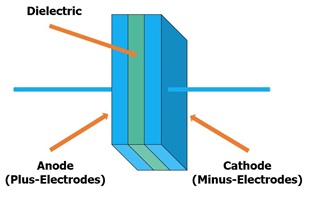A window fogs up when the air temperature drops below the dew point temperature. The dew point is the temperature at which the relative humidity is 100 percent, and the volume of gas is saturated. Falling below this level means that the room air cannot absorb any further moisture, and this is deposited on the surfaces. The dew point depends upon the air pressure, temperature and humidity. The air pressure cannot be changed, but the vehicle interior air can be regulated with technical systems such as the fog sensor and the air conditioning system.
Variant 1
As soon as the windows and the interior air are heated, the temperature rises above the dew point and the windows become clear.
Variant 2
Dry the air with the help of the air conditioner. The principle is simple:
Compressor, condenser, dryer unit, expansion valve and evaporator together form the air conditioner. The outside air is passed through the evaporator. This cools the air below the dew point as it flows past. The water from the air condenses at the evaporator and the water runs into the condensate drain. The dry and cooled air is then reheated, if necessary.
To ensure that the air conditioning system doesn’t run all the time, it’s controlled automatically in modern vehicles. This is the automatic climate control. To keep the windscreen clear, the air conditioning control unit needs the temperature of the car’s interior and also its humidity.
This is where the fog sensor comes into play.

In the automotive sector, the fog sensor usually consists of a capacitive thin-film sensor. This works in a similar way to a plate capacitor. The only difference is in the material used, which is located between the two electrodes (separating layer). The so-called "dielectric".
In the case of the fog sensor, the dielectric has the property of absorbing moisture. This leads to a change in the capacitance of the capacitor. The wetter the dielectric, the higher the capacitance. In this way, the climate control unit calculates the humidity in the interior.
In the case of windscreens with a Head-Up-Display, it is particularly important that the fog sensor in the vehicle works. If the windscreen fogs up while driving, the refraction of light from the water droplets in the Head-Up-Display can cause severe glare for the driver. The air conditioner detects the fog with the help of the fog sensor and switches on as needed.
The humidity in the interior should always be kept as low as possible to prevent fogging and freezing of the windows. A wet umbrella or floor mats should not be left in the vehicle to dry.
There are other ways in which moisture enters the interior.
1. Clogged climate condensate drain
The water condensed at the evaporator is usually directed through a rubber nozzle to the outside, in or just below the bulkhead. This rubber grommet can become clogged, condensate accumulates and eventually spills over into the interior.
2. Leaking heat exchanger
If the heat exchanger in the interior leaks, cooling water runs into the interior.
3. Leaking rubber seals/insulation
The rubber grommet, which sits at the transition between the engine's wiring harness and the vehicle body, can leak. Of course, there are also the usual suspects such as door rubbers, window rubbers or tailgate seals. In addition, moisture can get to the internal control unit through damaged cable insulation and possibly damage it (so-called capillary effect).
4. Hairline crack in the body
Hairline cracks may form in the body, allowing water to enter the interior.
5. Clogged rainwater drains
Very often there is mud behind the wheel arch cover of the front wheels. The rainwater in the water tank may not drain off and enters the interior via the cabin filter. In vehicles with a glass sunroof, the hose connections towards the tailgate and A-pillar may leak.
6. Leaking splash water hoses
If the rear washer nozzle is clogged and water is sprayed, a hose connection in the interior can be disconnected.
The above examples have all occurred at some time and are repeated regularly with a wide variety of models. If you have a vehicle with moisture in the interior, you can use these tips to help you.